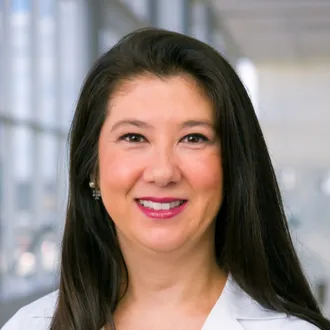Consultation Etiquette: 3 Essential Tips for Building Trust with Referring Clinicians

As a palliative care physician, I regularly collaborate with referring clinicians, including my oncology colleague Dr. Khoan Vu, with whom I’m sharing this byline. Though we have different backgrounds and training, we work together to ensure our patients get the care they need.
We once shared a patient, a 22-year-old man with stage 4 lung cancer, who needed help with symptom and pain management, and emotional support for coping with a grave diagnosis at a young age. When he arrived for a palliative care visit, sweating and short of breath, Dr. Vu and I quickly conferred. Working together, we were able to make sure our patient could get a CT scan, which showed disease progression. Our patient was quickly admitted and started treatment.
Partnering to help patients
It took good communication and collaboration to get our patient the care he needed. Our collaboration contributed to the extra year he lived, which he spent with his mother, who cared for him.
We recommend that palliative care clinicians step back and consider how they consult with referring clinicians. The best way to increase referrals is to build trust—in palliative care and each other as team players and collaborators—to meet patients’ goals. Building trust involves using good etiquette and finding the right communication strategies. Ultimately, maintaining good relationships with referring clinicians helps provide coordinated care to patients that is aligned with their goals of care.
"It took good communication and collaboration to get our patient the care he needed."
Communication gaps exist between referring and consulting clinicians
Research suggests that it’s not uncommon for communication gaps to develop when a clinician refers a patient to a specialist, even though everyone has good intentions.
Communication gaps often stem from time constraints. With most patient encounters limited to fifteen minutes, referring clinicians may not have time to share all of the details, leaving the consulting clinicians feeling they lack crucial information. Conversely, consulting clinicians may assume referring clinicians don’t have time to read lengthy reports, so they may not follow up promptly, leaving referring clinicians wondering about the patient’s status.
"Patients should have a unified care team, which requires closing [...] communication gaps."
Without good communication about status and potential options, incorrect assumptions can directly affect goals of care conversations and cause mixed messages. Patients should have a unified care team, which requires closing those communication gaps.
How you can help close communication gaps
To fix the communication gaps, you have to figure out what works best for each referring clinician. CAPC’s tutorial on consultation etiquette is a good resource, but it also comes down to getting to know each person individually and developing healthy relationships. Here are some strategies that can help you foster these relationships with referring clinicians:
1. Ask the referring clinician how they prefer to receive follow-up reports
I’ve found that one-on-one communication yields the best reports. For instance, Dr. Vu and I call each other to share our observations and concerns about our mutual patients. Not every patient visit necessitates a direct phone call, so we use our notes to communicate any changes in symptom management plans. But if anything major changes, I do call.
"Find out what works best for your referring clinicians so you can establish the best communication plan."
Another strategy is communicating your consult reports to the referring clinician through notes with key points about the patient’s goals of care or symptom management in a bullet point list. Any specific or critical details should be a warm handoff through phone or email.
Every referring clinician is different, so it’s important to first clarify expectations. First, find out if they are seeking a one-time consultation and recommendation or ongoing collaboration.
Then, ask the referring clinician about their preferences for follow-ups:
- Should you call them directly on their cell phone?
- Should you call their office and leave a message?
- Should you message through the EHR?
- Should you call them immediately if there are significant changes to goals of care or the patient’s status?
I work with a network of more than 750 clinicians across my state and can say that everyone has a different style. Find out what works best for your referring clinicians so you can establish the best communication plan.
Don’t let the referring clinician wonder what happened after referring a patient. I assume all consults will be co-managed, as that’s how palliative care is best practiced. In my notes, I let the referring provider know how I plan to proceed with the patient, including the timing for follow-up. You may instead choose to work together on a mutually agreeable schedule for updates or follow-ups. When Dr. Vu and I work together, timely follow-ups allow us to intervene more meaningfully, ultimately improving patient care.
"Don’t let the referring clinician wonder what happened after referring a patient."
2. Provide the referring clinician with details
The referring clinician may want your perspective on a several factors, including symptom management, difficult decisions, and prognostication. When relevant, they may also be interested in your view on the family’s involvement or potential family conflict.
As a palliative care clinician, you’re well-positioned to weigh in on those topics. You can spend more time with your patients to gather details, observe family and caregiver dynamics, ask questions, listen carefully for answers, and read between the lines. This insight allows you to give specific and relevant recommendations to the referring clinician.
3. Continue to educate colleagues about palliative care
Another perennial challenge for palliative care clinicians is ensuring that referring clinicians understand the role of the palliative care team. This should be a top priority. When we educate about palliative care using a patient example, we break down barriers and build up the perception of palliative care. As clinicians learn about and become comfortable with palliative care, they are more likely to recommend it to their patients.
"As clinicians learn about and become comfortable with palliative care, they are more likely to recommend it to their patients."
You may need to spend some time educating others on palliative care. Newer generations of clinicians are being exposed to palliative care in medical school and residency training, so they may have more familiarity with it. But you also can’t assume they have a nuanced grasp of all the responsibilities of the palliative care team.
For example, a clinician might know that palliative care can help a patient with serious illness. They might be aware of guidelines that recommend palliative care for anyone with a cancer or heart failure diagnosis. But they may not fully understand what the palliative care team can do for a patient. If this is the case, they won’t be able to clearly communicate the benefits of palliative care to their patients. You want to ensure everyone is on board with the palliative care consult—and knows what to expect.
The bottom line
When you maintain good consultation etiquette with your referring clinician, you are showing your commitment to professional courtesy—which can benefit your practice, too. If you don’t take your responsibility to your referring clinicians seriously, they may not feel they can count on you, which can impede future referrals.
Of course, your top priority is providing excellent care and support to your patients and their families. But working effectively with their referring clinicians can ensure your patients receive one unified message: their doctors are working together to give them the best possible care.

Be the first to read articles from the field (and beyond), access new resources, and register for upcoming events.
SubscribeEdited by Melissa Baron. Clinical review by Andrew Esch, MD, MBA.

